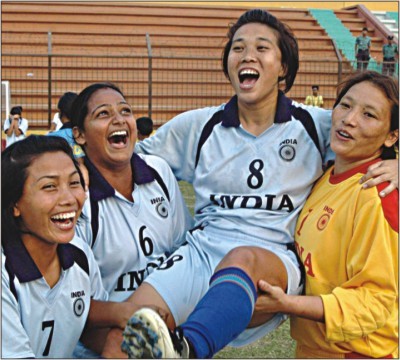“The future of football is feminine,” according to FIFA President Sepp Blatter. He’s not only known for his prediction of the future of the world’s most popular sport, but also for his belief that football can liberate women all over the world. But the problem here in India doesn’t concern the future of football. Rather, it addresses the future of the women who play the sport. Do they even have a bleak, watered down version of the future that professional football offers players over the world?
Football as a sport has been growing in India, persistently over the past few decades. With the professionalization of the I-league for men, its growth has only accelerated. The national league has really benefitted the game, players and the nation. The league has facilitated better media coverage, maintenance and development of stadiums and fields, a professional career for players with opportunities for growth and a source of income, as well as an inflow of foreign coaches and players. These facets have in turn led to higher interest and following of the league, modernizing of coaching practices and integration with world football, and obviously more players now want to make a career in Indian football. Kudos to AIFF and I league for that..!!
However, the state of women’s football in the country is sad. In fact, many will be surprised to know that it even exists. But it not only exists, but is definitely popular and widespread. There are thousands of women who play football across the country. Another misconception is that the game is restricted to the eastern regions of the country, but even this holds untrue. North, south, east, west…the game is booming, and that too without any stimulation or support. A majority of the women who play the game belong to the lower socio-economic strata of the society. The game doesn’t offer them pay or job opportunities, but they continue playing for the love of the game.
–
There are hardly any tournaments and leagues for women. All states are mandated to have a state league, as per the AIFF guidelines, but hardly any of them execute it. For a fact, the capital hasn’t had its state league in 5 years. The only other tournaments for women are the Under 17, Under 19 and Senior Women’s Football Nationals that are held once a year. The National Games also has women’s football as one of its events, but it happens to be a closed event, and only a select few states are invited to play. There are no monetary benefits or growth opportunities for the players, for these women are neither treated nor considered as players. The facilities provided are the mere basic, and unfit for even players from a poverty ridden country.
The question arises – if men were subjected to pursue football under the same conditions i.e. no pay, status or facilities; bad grounds, one tournament a year, no opportunity to improve, and no career opportunity and future benefits, would they continue PLAYING? Is the love of the game a strong enough reason to drive players to subject themselves to intensive training, discipline and hard work when they know that there will be no reward for their efforts in the end? The answer is NO. Then why are women any different from men? Is the constitutional right to gender equality only restricted to paper? Why is it that these players are being denied their right to play?
Professional leagues for women are not a new thing. They have been prominent worldwide since the late 60’s and 70’s. There are thousands of women worldwide who have successful careers in the field. Women’s Professional Soccer (USA), Frauen-Bundesliga (Germany), Toppserein (Norway), FA Women’s Super League (England), UEFA Champion’s League (Europe), L – League (Japan), Superliga Femina (Spain) and Serie A (Italy), to name a few, are the most popular and successful leagues being conducted.
Most of these leagues follow a 8, 12 or 14 team format, except for the UEFA Champion’s League that is played by 45 teams from all over Europe. However, they all are conducted every year with a season that lasts a minimum of 6-8 months. Since the marketability and commercialisation of women’s football isn’t yet at par with that of men’s football, the most impressive facet of these leagues is their business model. These leagues have a close relationship with men’s leagues to cut costs on staff and facilities, and for marketing. Despite of these cutbacks, leagues like the WPS manage to pay the players an average salary of $25,000 to $32,000 for a seven-month contract, with top players like Marta, the Brazilian star player, making $500,000 a year.
Where does India, an emerging world superpower, stand on this ground? Is there any scope of a professional league for women; where, even an unprofessional one doesn’t operate? Does the AIFF even care for the sport when it concerns women? Or is this just another consequence of India being a poverty ridden third world country where discrimination based on caste and creed are an offense but those based on gender are a way of life?
It has been done before, but it’s just waiting to happen in India. There isn’t any lack of interest or shortage of players in our country. What is lacking is the support and initiative to mobilise and nurture these players to their full potential. A national pro football league for women is well overdue. The question is how many decades will it take AIFF to start it.
Kuhelika Guha
(The author is a national level footballer)
